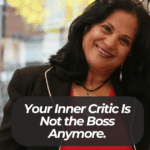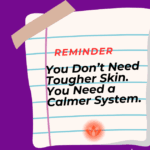You want to rest. You plan to rest. Your nervous system is tired. But the moment you do, your chest tightens. Your thoughts speed up. You start scanning for what you’ve forgotten.
This isn’t a time management issue. It’s a safety pattern.
And if you’re someone who prides themselves on being reliable, driven, or composed, this will hit especially hard:
Your nervous system might have learned to mistake rest for weakness.
This isn’t discussed in peak performance circles, but it’s one of the biggest reasons high achievers struggle to feel calm even when everything is “fine.”
Let’s unpack the hidden link between rest, risk, and identity and discuss breaking the pattern without losing your edge.
High performers aren’t known for their ability to rest. They’re known for pushing through. Delivering under pressure and outworking the doubt.
But here’s what I’ve seen repeatedly: beneath the surface of hyper-productivity isn’t drive.
It’s fear. Not of failure. But of slowing down.
Because somewhere along the line, your system learned a quiet, powerful message:
Rest is dangerous. Stillness is exposure. Recovery = weakness.
And this subconscious wiring, not your calendar or goals, determines how safe you feel doing… nothing.
Why You Can’t “Switch Off” (Even When You’re Exhausted)
You know the signs:
→ You finish a project and immediately start planning the next.
→ You feel irritable or unsettled on weekends or during time off.
→ You tell yourself rest is essential, but the moment you stop, you feel anxious, guilty, or behind.
This isn’t because you lack discipline. It’s because your nervous system doesn’t register rest as safe.
Instead, it equates stillness with loss of control. With criticism. With falling behind. With being exposed or left behind.
So what looks like “I can’t switch off” is actually your body protecting you.
The Safety Trap: Where This Belief Gets Wired In, Your Nervous System is tired!
This pattern doesn’t come from nowhere. It’s built.
It occurs often in childhood, sometimes in corporate culture. And it is always reinforced by a world that praises “high performance” but punishes pause.
You may have been praised for being the “responsible one.”
For staying busy. For never asking for help. For holding it all together.
Somewhere along the way, output became identity.
And when output stops, the question arises: Who am I now?
Your nervous system took notes.
It didn’t just learn to strive.
It learned to survive by striving.
The Hidden Cost of High-Functioning Exhaustion
This is why traditional “self-care” advice falls flat.
Because it’s not about the need for rest, you already know you’re tired.
It’s about the permission to rest and what your system believes happens if you do.
Let’s break this down:
→ If rest triggers guilt, it’s not restorative, it’s stressful.
→ If stillness creates panic, it’s not laziness; it’s a nervous system response.
→ If slowing down feels unsafe, it’s not resistance, it’s protection.
This is what I call the safety trap.
You stay in motion not because you’re aligned… but because you’re avoiding what stillness might surface.
Real-Life Story: From Restless to Regulated
One of my clients, a high-achieving founder with a relentless pace, once said:
“Every time I try to slow down, I feel like I’m losing my edge. Like the success will vanish if I stop watching it.”
She wasn’t exaggerating.
Her system had linked rest with risk, specifically, the risk of being seen as weak, replaceable, or irrelevant.
Through the RESET System™, we didn’t just talk about rest. We rewired her nervous system to interpret rest as safe.
We rebuilt capacity for stillness without shame, rest without collapse, presence without panic.
What happened next? She didn’t slow down in the way she feared she would. Her strategy got clearer. Her creativity returned. Her decision-making became more precise. Not because she forced rest. But because her body stopped bracing against it.
This Is the New Model of High Performance
The old model says:
- Push harder
- Rest when it’s over
- Be the last one standing
But here’s the truth:
Rest isn’t the opposite of performance.
It’s what makes performance sustainable.
Your nervous system doesn’t care about your goals.
It cares about your safety.
So if success has always meant pressure, urgency, and over-responsibility, your body will keep chasing the familiar… until you teach it something new.
And that’s what we do in my free masterclass.
You’ll Learn:
→ Why your nervous system rejects rest (even when your mind craves it)
→ How high-functioning behaviour can mask deep dysregulation
→ What to do when slowing down triggers more stress than it relieves
→ How to rewire rest as safe, not scary—so you can actually feel rested
If you’re tired of needing permission to pause…
If you’ve built success on stamina and are ready to build it on self-trust…Book a Call.
👉 Join the free masterclass. We don’t just talk about rest. We train your system to receive it.






